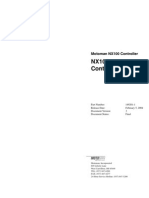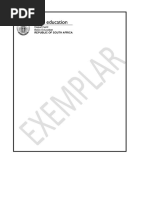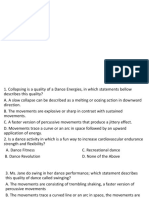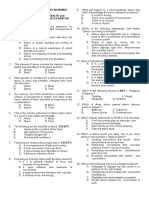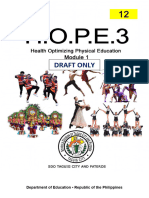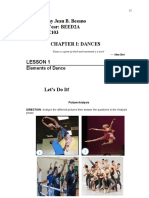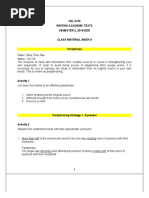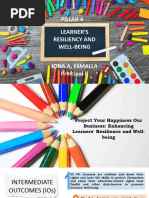FINAL GEC Grade 9 Dance English
FINAL GEC Grade 9 Dance English
Uploaded by
montshiwat72Copyright:
Available Formats
FINAL GEC Grade 9 Dance English
FINAL GEC Grade 9 Dance English
Uploaded by
montshiwat72Copyright
Available Formats
Share this document
Did you find this document useful?
Is this content inappropriate?
Copyright:
Available Formats
FINAL GEC Grade 9 Dance English
FINAL GEC Grade 9 Dance English
Uploaded by
montshiwat72Copyright:
Available Formats
NATIONAL ASSESSMENT
TASK
2023
GRADE 9
Subject: Creative arts
Paper: Dance
Marks: 50
Duration: 60 Minutes
excluding 15 minutes reading time
This test consists of 14 pages, excluding the cover page
Instructions to the learner
1. You will receive 15 minutes reading time before you begin answering this test.
2. Read your questions carefully before you answer.
3. Answer all questions.
4. Use the answer sheet to write your answers.
The test starts on the next page.
Do not start writing until you are told to do so.
Grade 9 Creative Arts (Dance): 1
November 2023
SECTION A
Question 1
Choose the correct option from the responses provided. Write down only the correct letter.
Use the text below to answer questions 1.1 to 1.3.
Dance requires every dancer to be disciplined. Learners are expected to follow dance
conventions which will help them to be disciplined professional dancers. The conventions
include the importance of warming up and cooling down exercises.
1.1 Describe what dance conventions are.
A exercises that we always do in the dance class
B dance techniques and skill development
C the manner in which dancers are expected to conduct themselves
D teaches learners to disrespect one another (1)
1.2 What is the importance of warming up in a dance class?
A to make the muscles and the joints inflexible
B to prepare the muscles to work harder than normal
C to decrease blood flow in the muscles
D to cool down the body after dancing (1)
1.3 What is an importance of cooling down after a vigorous or strenuous activity?
A to decrease blood flow and increase the heart rate
B to immediately stop dancing and rest
C to gradually bring the heart rate and breathing back to normal
D to start practising another exercise routine (1)
Grade 9 Creative Arts (Dance): 2
November 2023
1.4 When doing leg movements while standing, which one is referred to as the
supporting leg?
A the one that you are standing on
B the one that is moving
C the two legs you are standing on
D the two legs you are dancing with (1)
1.5 Which exercises build stamina?
A body part isolation
B arm swings
C non-locomotor movements
D aerial movements (1)
1.6 When creating a short, fast dance sequence, you must pay attention to
details of ...
A the movements of the feet and arms.
B steps, rhythm, direction, position and mood you are expressing.
C costumes and props.
D doing random dance moves. (1)
Grade 9 Creative Arts (Dance): 3
November 2023
Use the statement and the picture below to answer questions 1.7 to 1.10.
Proper body alignment and posture are essential to dancers as these aspects
make them appear more elegant and confident. The picture below shows
body posture and alignment.
[Source: https://th.bing.com/th/id/R.331932ccbd23fc0ae3129dd20a311548?rik=t4d6u2HC3]
1.7 What does alignment refer to?
A keeping the body balanced with proper posture
B the movement of only the upper body
C the expression of emotions through movement of the body parts
D the proper positioning of the body in relation to the movement
being performed (1)
1.8 Which statement best describes the importance of alignment?
A maintaining the imbalance and stability
B maintaining the balance and instability
C maintaining the imbalance and instability
D maintaining the balance and stability (1)
Grade 9 Creative Arts (Dance): 4
November 2023
1.9 Why is correct posture important in dance?
A It helps the dancers to remember choreography more easily.
B It helps the dancer to express emotions through movements on
stage.
C It helps to prevent injuries and allows for a greater range of
movements.
D It helps the dancer to appear taller and more confident on stage. (1)
1.10 What is a common sign of incorrect posture?
A straight spine
B rounded shoulders
C relaxed shoulders
D feet shoulders-width apart (1)
1.11 What does the mastery of dance involve?
A understanding the music only
B practising physical skills, choreography and musicality
C only focusing on physical skills
D only focusing on the choreography (1)
1.12 What does attention to detail refer to, in dance?
A the ability to memorise choreography quickly
B the ability to perform difficult dance moves
C the ability to focus on technical aspects of dance
D the ability to improvise and create new movements (1)
Grade 9 Creative Arts (Dance): 5
November 2023
1.13 What is the importance of paying attention to detail?
A It allows dancers to execute precise movements with accuracy
and support.
B It allows dancers to improvise and create unique movements.
C It helps the dancers to remember choreography and perform in
unison with others.
D It allows the dancers to perform with emotion and passion. (1)
1.14 ‘Coordination is an essential skill in dance.’
Which statement is the most accurate one?
A Coordination is not important in dance.
B Coordination is only important in certain types of dance.
C Coordination is important in all types of dance.
D Coordination is important for only the lead dancer. (1)
1.15 Which of the following statements best describes body-part isolation?
A moving the entire body in fluid and continuous motions
B moving multiple body parts at the same time
C moving one part of your body while the rest are still
D moving two body parts while the rest are still (1)
1.16 What does choreography refer to?
A a dance career
B someone who teaches dance steps
C a type of music or genre
D a dance composition (1)
Grade 9 Creative Arts (Dance): 6
November 2023
1.17 What does locomotor movement refer to?
A movements that travel across space
B movements that take the body high into the air
C movements that keep the body in the same space
D movements that change from time to time (1)
1.18 What do we call the pace or speed of the music?
A levels
B tempo
C musicality
D band (1)
1.19 Identify the correct elements of dance.
A energy, music and space
B rhythm, harmony and melody
C space, time and force
D time, props and energy (1)
1.20 What is the difference between own space and shared (general) space in
dance?
A Own space is the area where the dancer performs alone, while
shared space is the area where dancers perform together in a
group.
B Own space is the area where dancers perform with others, while
shared space the dancer is dancing alone.
C Own space is the dancer’s personal space, while shared space
refers to the stage space.
D Own space is the dance space, while shared space is the
performance area. (1)
Grade 9 Creative Arts (Dance): 7
November 2023
1.21 Identify the correct meaning of a dance sequence.
A a specific dance movement performed in random order
B a specific order of dance moves arranged to form a complete dance
C a specific dance movement performed by different individuals
D a specific dance movement used for cultural events (1)
1.22 Using the performance space, how would you create a dance sequence?
A forward, backwards, high or low using all parts of the stage
B speeding up or slowing down
C light and sudden, strong and sustained
D altering and shifting the place of the movement (1)
1.23 How can musicality be used as a stimulus when composing a dance
sequence?
A to determine the number of dancers needed in the sequence
B to create complex and difficult movement patterns
C to co-ordinate the timing and pacing of the movement with the music
D to select the costume and props for the performance (1)
1.24 Describe ways a dancer can use to stay focused during a performance.
A breathing and body movements
B standing still and posing
C correcting mistakes on stage
D practising big jumps on stage (1)
Grade 9 Creative Arts (Dance): 8
November 2023
1.25 What is the correct description of positive space?
A the space around the dancer’s body
B the space between two dancers
C the space occupied by the dancer’s body
D the space where the audience is seated (1)
1.26 What is dance improvisation?
A unplanned or unrehearsed dance performance
B a pre-planned and rehearsed dance performance
C a group performance for an audience
D a dance performed by only one person (1)
1.27 What do we call the ability of a dancer to move freely on stage?
A expressive
B mood
C spotting
D mobility (1)
1.28 When everyone does the same steps as part of a dance, it is known as …
A unison
B transition
C canon
D repetition (1)
Grade 9 Creative Arts (Dance): 9
November 2023
1.29 Which of the following is the best accompaniment when composing a dance
sequence?
A costumes and props
B a poem, rap, song and music
C boots, overalls and a helmet
D structure, originality and confidence (1)
1.30 When a dancer leads and the others follow with the same movement, or
dancers are doing a movement one after the other, it is referred to as …
A unison.
B canon.
C call and response.
D direction. (1)
1.31 How can a dancer use repetition in a dance composition?
A by allowing the dancers to improvise their movements
B by creating long simple dance steps
C by creating a dance that is suitable for the target audience
D by using the same movement phrase multiple times (1)
1.32 Which statement best describes stillness in a dance?
A a continuous fast movement in dance ending with a slow motion
B the use of soft and slow movements in the middle of a dance
C dancers holding hands indicating the end of a performance
D a pause or a rest or a completion of a dance movement (1)
Grade 9 Creative Arts (Dance): 10
November 2023
1.33 What is the correct term used to describe the opening session of a dance?
A middle
B entrance
C beginning
D ending (1)
1.34 When a dancer maintains and controls the centre of the body, while moving, we
refer to …
A diaphragm.
B core stability.
C flexibility.
D hamstrings. (1)
1.35 Why is commitment to movement important in dance?
A It helps to exercise the body only when it is convenient for the dancer.
B It helps to make fewer excuses to skip workouts when the dancer is
tired.
C It helps to improve dance technique, performance skills and physical
health.
D It helps to go to the gym once or twice a month to meet other dancers. (1)
1.36 What is an indigenous South African dance?
A dance steps and style that originated in south Africa
B popular dance found in south Africa
C a particular traditional dance found in South Arabia
D a dance performed in Africa as part of a cultural ceremony (1)
Grade 9 Creative Arts (Dance): 11
November 2023
1.37 Which direction is considered clockwise when moving in a circle?
A dancers moving to the left
B dancers moving to the right
C dancers moving to the left and backwards
D dancers moving to the right and forward (1)
1.38 How best can you describe a polished dance performance?
A a dance performance that has a rough and unfinished look
B a dance performance that is simple and lacking in creativity
C a dance performance that is messy and disorganized
D a dance performance that is refined and well-rehearsed (1)
1.39 Which option best describes reflecting on one’s own dance experience?
A It involves considering personal growth and development as a
dancer.
B It involves analysing the technical skill of other dancers.
C It involves identifying flaws in one’s dance technique and other
dancer’s flaws.
D It involves comparing oneself to other dancers. (1)
1.40 Which statement best describes a gumboot dance?
A a dance form that uses only the lower body parts and gumboots
B a dance form that originated in the united states and is performed by
miners using gumboots
C a dance form that is often performed in a seated position and uses
gumboots to create rhythms
D a South African dance form, that started in the mines as a form of
resistance, danced with gumboots (1)
[40]
Grade 9 Creative Arts (Dance): 12
November 2023
SECTION B
Question 2: Case study
Read the case study and answer the questions that follow.
The role of music in dance
Music is a significant part of choreography. Together with the movement
and emotions shown by the dancers, music sets the mood and serves as
a stimulus in dance. Music can also change the mood of the dance
performance.
Slow music can set a sad, heavy mood, while fast music can make
everyone feel happy and excited. Poetry, rap, props, pictures or images
can also serve as stimuli, as they inspire or evoke a response and cause
people to create a dance sequence.
Musicality also happens when a dancer is able to understand and respond
to music through movement, while spatial awareness helps the dancers to
be aware of the space they use with others.
The dancer must be able to compose choreography and a dance sequence
by using composition structures such as transition, beginning and ending,
repetition, stillness, etc. Music can also help the dancer to envision the
dance routine or sequence.
It is very important that dancers try at all costs to keep the dance
performance interesting and retain the audience’s attention by applying
contrasting dynamics which is the combination of two opposing forms of
movement used to create a particular feeling in dance.
[Adapted from Study and Master Grade 9 Learner’s book]
Grade 9 Creative Arts (Dance): 13
November 2023
2.1 Explain what is meant by the term ‘stimulus’ in the case study. (1)
2.2 Music has been identified as one of the stimuli in dance.
Mention any TWO other stimuli in dance referred to in the case study,
other than music. (2)
2.3 With reference to the case study, identify terms that match the following
desciptions.
2.3.1 When the dancer is able to understand and respond to music in
dance. (1)
2.3.2 To be aware of the body and the space that you are sharing with
others. (1)
2.3.3 The combination of two opposing forms of movement used to create
a feeling. (1)
2.4 As one of the composition structures, discuss where a dance can begin
and end to make it effective. (2)
2.5 Briefly describe the correct safe landing principle from aerial movements
in the correct order. (2)
[10]
End of test
Grade 9 Creative Arts (Dance): 14
November 2023
You might also like
- BP Aviation Audit ChecklistDocument56 pagesBP Aviation Audit ChecklistHeiri100% (3)
- Biri Lesson Plan CheerdanceDocument6 pagesBiri Lesson Plan CheerdanceNas Lee64% (22)
- 2ND Quarter PT - Spa Dance 7 AdobeDocument3 pages2ND Quarter PT - Spa Dance 7 AdobeMa. Shayne Rose Villafuerte67% (3)
- Rebar Cut & Bend WorkDocument6 pagesRebar Cut & Bend Workajit karandikarNo ratings yet
- Grade 12 - PE and Health 3Document6 pagesGrade 12 - PE and Health 3Robert Coloma100% (2)
- NX100 Controller ManualDocument405 pagesNX100 Controller ManualErik Acosta100% (2)
- BOQ Offer R0 - 30122020 - C&S PLANT TENDER - BOQ TEMPLATEDocument34 pagesBOQ Offer R0 - 30122020 - C&S PLANT TENDER - BOQ TEMPLATERini AdelinaNo ratings yet
- CVDisease NUTRIDocument30 pagesCVDisease NUTRIMariano Marbella100% (1)
- Grade 9 Dance English - TestDocument16 pagesGrade 9 Dance English - TestIG Singa IINo ratings yet
- P.E 2 Mditerm ContempoDocument2 pagesP.E 2 Mditerm ContempoMARK JOSEPH ELAPENo ratings yet
- Physical Education 12 Nat ReviewerDocument2 pagesPhysical Education 12 Nat ReviewerAngelica Caranzo LatosaNo ratings yet
- Pe QuizDocument9 pagesPe QuizRobert ColomaNo ratings yet
- Health Optimizing Physical Education 3: Quarter 2 Week 7Document10 pagesHealth Optimizing Physical Education 3: Quarter 2 Week 7Maria Lutgarda R. TumbagaNo ratings yet
- NAT-REVIEWER-IN-PHYSICAL EDUCATIONDocument2 pagesNAT-REVIEWER-IN-PHYSICAL EDUCATIONviquelyn engbinoNo ratings yet
- Creative Arts Grade 8 EXEMPLAR November 2022Document15 pagesCreative Arts Grade 8 EXEMPLAR November 2022ggiggi570No ratings yet
- NAT-REVIEWER-IN-PHYSICAL EDUCATIONDocument7 pagesNAT-REVIEWER-IN-PHYSICAL EDUCATIONMailyn SimanNo ratings yet
- Grade 8 June Exams 2022Document19 pagesGrade 8 June Exams 2022zanelemvubeloNo ratings yet
- NAT-REVIEWER-IN-PHYSICAL EDUCATIONDocument4 pagesNAT-REVIEWER-IN-PHYSICAL EDUCATIONMira Rochenie CuranNo ratings yet
- ACTIVITY On LESSON 1 Nature and Elements of DanceDocument6 pagesACTIVITY On LESSON 1 Nature and Elements of DancekimNo ratings yet
- HUMANITIES PE and CPARDocument4 pagesHUMANITIES PE and CPARMaricel BeranaNo ratings yet
- Grade 12 PE and Health 3Document7 pagesGrade 12 PE and Health 3Cin DyNo ratings yet
- Nat-Physical EducationDocument8 pagesNat-Physical EducationArnel LomocsoNo ratings yet
- Nat Reviewer in Physical EducationDocument8 pagesNat Reviewer in Physical Educationbertz sumaylo100% (1)
- Pretest in Hope 3Document4 pagesPretest in Hope 3leslie ferrerNo ratings yet
- PE 4th QuarterDocument3 pagesPE 4th QuarterMaribel Dizon Mangio0% (1)
- ExamDocument4 pagesExamBilly JoeNo ratings yet
- Grade 9 Drama English TestDocument15 pagesGrade 9 Drama English TestlutendomafenyaNo ratings yet
- Grade 12: Module inDocument10 pagesGrade 12: Module inMario AnacletoNo ratings yet
- Final Exam Grade 12 PEHDocument2 pagesFinal Exam Grade 12 PEHJoeward Perez100% (1)
- Lesson Plan in MapehDocument3 pagesLesson Plan in MapehKenneth Babiera78% (9)
- Module 1 HOPE 3Document10 pagesModule 1 HOPE 3Jewel Anne A. DimaguilaNo ratings yet
- Dance-2Document7 pagesDance-2makhwanyakagisoNo ratings yet
- AC PDF TV4 2021-2022 PART 5 Dance and TheatreDocument27 pagesAC PDF TV4 2021-2022 PART 5 Dance and Theatrelaurafredriksen2008No ratings yet
- Jeiel Richardson - ELEMENTS OF DANCEDocument2 pagesJeiel Richardson - ELEMENTS OF DANCErichardsonjeiel7No ratings yet
- Grade 9 Drama English TestDocument18 pagesGrade 9 Drama English TestLenaNo ratings yet
- Suamatif Harian Seni Tari KLS 5 TH 23-24Document4 pagesSuamatif Harian Seni Tari KLS 5 TH 23-24SD Pemuda BangsaNo ratings yet
- Semi-Detailed Lesson Plan in Rhythmic Movements SkillsDocument3 pagesSemi-Detailed Lesson Plan in Rhythmic Movements SkillsMD Badilla100% (1)
- Mapeh10 Q4Document4 pagesMapeh10 Q4maryjoy.biescasNo ratings yet
- HOPE Review (1st Sem, 2nd QTR) - MinDocument14 pagesHOPE Review (1st Sem, 2nd QTR) - Minlalla.lilli026No ratings yet
- Dance Theory: An Introduction To The FundamentalsDocument69 pagesDance Theory: An Introduction To The Fundamentalsluckyswiss7776848No ratings yet
- Contemporary DanceDocument26 pagesContemporary DanceGherdine Khristine Dela CruzNo ratings yet
- Quarterly Assessment 1Document2 pagesQuarterly Assessment 1Sushimita Mae Solis-AbsinNo ratings yet
- QE 2 4 MAPEH (1)Document5 pagesQE 2 4 MAPEH (1)Annabelle ForroNo ratings yet
- Answer Sheet On The Quiz For Nature and Type of DanceDocument5 pagesAnswer Sheet On The Quiz For Nature and Type of DanceG25 Trisha Elaine SalanapNo ratings yet
- Pe 12 Hope3 Q1 M1Document10 pagesPe 12 Hope3 Q1 M1Lorvin PalattaoNo ratings yet
- Grade 12 Shs Hope q2 m5Document17 pagesGrade 12 Shs Hope q2 m5rap leeNo ratings yet
- Physical Education and Health 12Document11 pagesPhysical Education and Health 12Flin MilanNo ratings yet
- PE12.2 TQDocument4 pagesPE12.2 TQAnalyn Etang GabunilasNo ratings yet
- G12-Lesson 1-Nature of Dance - Pe3Document21 pagesG12-Lesson 1-Nature of Dance - Pe3Xhiandrie CanlasNo ratings yet
- Path FitDocument8 pagesPath FitMarie Maraniag0% (1)
- P.E 2 MidtermDocument2 pagesP.E 2 MidtermMARK JOSEPH ELAPENo ratings yet
- Art 002-Lesson 19 SasDocument4 pagesArt 002-Lesson 19 Sasdaphneelouise720No ratings yet
- PE 103 DANCES Unit 1 History of DanceDocument9 pagesPE 103 DANCES Unit 1 History of DanceTrish GanaciasNo ratings yet
- Name: Ressy Jean B. Besano Course & Year: BEED2A Subject: PE103 Chapter I: DancesDocument4 pagesName: Ressy Jean B. Besano Course & Year: BEED2A Subject: PE103 Chapter I: DancesRessy Jean B. BesanoNo ratings yet
- RTP Spa 7 Dance QTR 3 Melc 1 Week 1 Sdo SilayDocument22 pagesRTP Spa 7 Dance QTR 3 Melc 1 Week 1 Sdo SilayJoel Estupa100% (1)
- History of DanceDocument7 pagesHistory of DancePhrexilyn Pajarillo100% (1)
- 2022 CA Dance Grade 8 Term 2 TESTDocument3 pages2022 CA Dance Grade 8 Term 2 TESTLUCKY MBEDZINo ratings yet
- Pe12 Line DanceDocument8 pagesPe12 Line DanceBabylin FrondaNo ratings yet
- Quarterly Assessment 1Document2 pagesQuarterly Assessment 1Sushimita Mae Solis-AbsinNo ratings yet
- Creative Arts Grade 7 Memos All ArtformsDocument15 pagesCreative Arts Grade 7 Memos All Artformsmaarten77No ratings yet
- Pre Test Hope3 1ST SemesterDocument4 pagesPre Test Hope3 1ST SemesterREALYN CALMADANo ratings yet
- GROUP 1 Narrative ReportDocument7 pagesGROUP 1 Narrative ReportShen AcodesinNo ratings yet
- Test P.E and HEALTH 12Document3 pagesTest P.E and HEALTH 12Jones Wilbur B. TelmosoNo ratings yet
- PE-SHORT-REVIEWERDocument4 pagesPE-SHORT-REVIEWERianenovahmunezycotNo ratings yet
- Cel 2103 - Class Material Week 8 - Supporting Details - (Choo Vern Han - 202718)Document9 pagesCel 2103 - Class Material Week 8 - Supporting Details - (Choo Vern Han - 202718)Mohammad BappyNo ratings yet
- Outbreak Undead - Deep Space - Second EditionDocument241 pagesOutbreak Undead - Deep Space - Second Editionhalafaxx80% (5)
- THBT Abortion Should Be IllegalDocument4 pagesTHBT Abortion Should Be IllegalSiti AisyahNo ratings yet
- Implante AlemãoDocument15 pagesImplante AlemãoIsteicy CortezNo ratings yet
- Medtronic ENT InstrumentsDocument490 pagesMedtronic ENT Instrumentsdrtarek255442No ratings yet
- Foundation of Special and Inclusive Education PDFDocument2 pagesFoundation of Special and Inclusive Education PDFGerico NuquiNo ratings yet
- Mini ProjectDocument32 pagesMini Projectbennyk062No ratings yet
- Introduction To CriminologyDocument80 pagesIntroduction To CriminologyFulufhelo MatshetheNo ratings yet
- Health Equity Style Guide CDC Reducing StigmaDocument11 pagesHealth Equity Style Guide CDC Reducing StigmaLavinia CasaNo ratings yet
- 29464c26078b8f4ad48a3fe7aae9823eDocument16 pages29464c26078b8f4ad48a3fe7aae9823eBALAMURUGAN RNo ratings yet
- Grade 3-Mapeh 1ST QuarterDocument12 pagesGrade 3-Mapeh 1ST QuarterMary ann NarvatoNo ratings yet
- Poster FinalDocument1 pagePoster Finalapi-652215108No ratings yet
- Practice 91Document5 pagesPractice 91Trúc ThanhNo ratings yet
- Kurva WhoDocument1 pageKurva WhoIlhamDevirxaNo ratings yet
- Advance Brochure UKDocument6 pagesAdvance Brochure UKnotaden1849No ratings yet
- 3rd Quarter - 10 MAPEH-STEDocument5 pages3rd Quarter - 10 MAPEH-STECharles Jayson OropesaNo ratings yet
- Eeg, PSG, Sleep DisordersDocument48 pagesEeg, PSG, Sleep DisordersIoana MunteanuNo ratings yet
- Nutritional QuestionnaireDocument8 pagesNutritional QuestionnaireTheodorus Samuel RahardjaNo ratings yet
- Whether A Patient Is Entitled For Emergency Medical Care, and Whether Medical Professionals Have A Duty To Provide Emergency Medical CareDocument5 pagesWhether A Patient Is Entitled For Emergency Medical Care, and Whether Medical Professionals Have A Duty To Provide Emergency Medical CareSoumiki GhoshNo ratings yet
- Obsessive Compulsive Disorder and Migraine: Case Report, Diagnosis and Therapeutic ApproachDocument4 pagesObsessive Compulsive Disorder and Migraine: Case Report, Diagnosis and Therapeutic ApproachRaaqa AnastaNo ratings yet
- Code of Conduct Policy: Med Plus Group of CompaniesDocument12 pagesCode of Conduct Policy: Med Plus Group of CompanieskishoreNo ratings yet
- MECO-TECO ProposalDocument2 pagesMECO-TECO ProposalEm-Em 'Emstein' Lamento-VillegasNo ratings yet
- Presentation-Learner's Resiliency and Well-BeingDocument12 pagesPresentation-Learner's Resiliency and Well-BeingDayday Abello-EsmallaNo ratings yet
- Frost Bite ManagementDocument7 pagesFrost Bite ManagementrurinardiyantiNo ratings yet
- Mycah Research ProposalDocument9 pagesMycah Research ProposalJessa Mae GalanidaNo ratings yet





